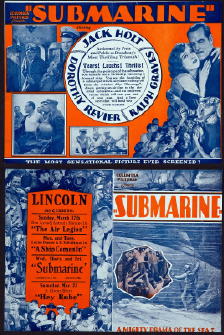April 2014
Monthly Archive
Sun 6 Apr 2014
DAN SLOTT (writer) and JUAN BOBILLO & MERCELO SOSA (artists) – “Dead Certain.†She-Hulk: Marvel Comics, Number 3, July 2004.
You may or may not keep up with comic books, but no, they’re not 10 cents any more. (The price of this one is $2.99, but as a back issue, which by the time you read this, as late as it will surely be, I am sure you will be able to find a copy for far less than that.)
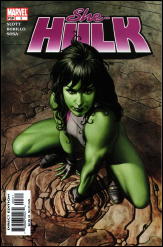
And the vast majority of most comic books run in long continued stories (“arcsâ€), which means that if you pick one up a random, it will be part two of six, and you won’t have a clue about what’s going on.
This particular issue, though, is a rarity – a story told all in one issue (but with lots of personal interplay going on, adding to the characterization, but not harmful to the plot to any discernible degree if you skip over it).
I’ll assume that everyone is familiar, to some degree or another, with The Incredible Hulk – the much longer-running comic book series which was the basis of a television series some years ago and then, much more recently, a semi-disaster of a full treatment movie overladen with special effects.
This latest version of the She-Hulk book series comic bis but another in Marvel Comics’ long line of efforts to siphon off some of the male Hulk’s popularity by creating a successful female counterpart – and no, I’m not going to get into all of the other attempts.
Suffice it to say, perhaps that I believe that She-Hulk’s alter ego has always been Jen Walters, who may or may not has always been a top-notch lawyer in her real life, but who has the ability to transform herself into a seven foot tall green-skinned amazonian super-hero. Unlike the Hulk, whose intelligence (and skin color) seems to vary at the whim of the writer at the time, She-Hulk seems to be as intelligent as Jen Walters, but (naturally) much more powerful.
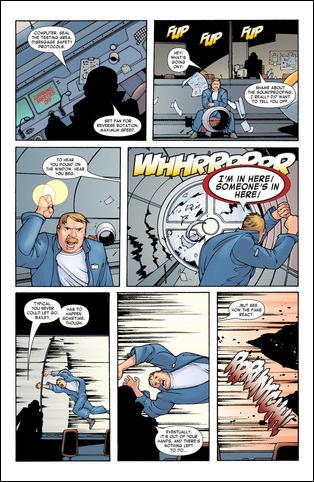
Um, I seem to have lost some readers who have gone on the next review. If you’re still with me, I’ll speed things up a little, but a little background would seem to be useful in the context of why I’m even telling you about this particular issue.
After aircraft engineer Bailey Briggs is brutally murdered – by trapping him in a wind tunnel with one of his test engines still running – the chief witness against the defendant at the subsequent trail is – the ghost of Bailey Briggs. I’ll repeat that. His ghost. I believe this may be a first – one for the books, you might say – but if you can say otherwise and prove me wrong, I’d certainly like to know about it.
An interesting twist is that Jen Walters, working for the defense, does not believe Bailey Briggs’ ghost – and yes, the judge rules that precedent has been established for such a turn of events, at least in the Marvel Universe – but why would a dead man lie?
With She-Hulk’s assistance in carrying out the investigation, a most satisfactory answer to that question is obtained, and you’ll have to read the story for yourself to discover what it is. Neatly done, it is.
PostScript: In terms of the artwork, Jen Walters and She-Hulk are drawn more baby-faced in appearance than appeals to me, but in their own stylish way, the pair of artists responsible for this issue (pencils and inks) carry off their half of the story-telling with nearly as much aplomb as the gentleman who wrote the words.
Fri 4 Apr 2014
Posted by Steve under
Reviews[3] Comments
Reviewed by DAVID VINEYARD:
JEREMY LLOYD – The Further Adventures of Captain Gregory Dangerfield. Michael Joseph, UK, hardcover, 1973. St. Martin’s Press, US, hardcover, 1974. No paperback edition.
Tock, tock, tick, tack, tock went the keys of the ancient Remington typewriter, and on the crisp white foolscap paper, marked only slightly by the tea stain on the top right hand corner, appeared in bold black type the startling information,
THE GAME IS UP, MR. GATES, A NEW DETECTIVE NOVEL BY HENRY POTTS.
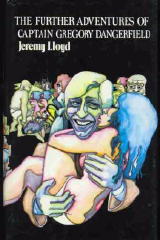
Henry Wordsworth Potts writes detective stories, and none too successfully, that is until he borrows a typewriter, an old Imperial, to finish his latest opus, and discovers the machine is haunted.
Much to his surprise his fingers leap across the keys and type out The Further Adventures of Captain Gregory Dangerfield, and a voice, strikingly like that of George Sanders, informs him that he is now under the control of the late P.W. Arnold, author of the Dangerfield series, and will not only write the book, but live them.
And with that his everyday life at the boarding house at Ranliegh Road in Streatham becomes rife with international adventure, beautiful scantily clad women, and dastardly villains with Potts now dashing about in Dangerfield’s Bugatti Royale — the one given him by King Zog of Roumania…
By turns increasingly funny, and increasingly mad, the book follows our poor Mr. Potts as he is plunged into Dangerfield’s world replete with super-villains, femme fatales, deadly traps, and increasingly embarrassing situations — like when he washes ashore on a tropical beach:
“It was Zola,” penned the Author, “the girl whose message for help he had answered, and now her beautiful tear filled eyes shone with relief, and making the sign of the cross over her magnificent bosom, which strained for release beneath the thin material of her shirt, she waded into the surf to help the one man in the world who could save her…”
“But Captain Gregory Dangerfield,” said P.W. Arnold admiringly, “with his incredible powers of recovery had already got his strength back, and holding Zola with his arms of steel, while she rained kisses on his handsome salty lips, he carried her to shore.”
In any other circumstances Mr. Potts would have enjoyed Miss Martin’s attentions, but her hot kisses, some of them on his spectacles, made it hard to see.
The Author, ignoring his plight, continued, ‘And so, looking like a Greek god, bearing Aphrodite in his arms, Dangerfield’s magnificent bronzed naked body emerged from the sea.”
Mr. Potts spluttered and his heart missed a beat. He’d been pleased to hear he was bronzed; but naked! He clutched tightly to Miss Martin, he mustn’t put her down. But he certainly was naked … this was already an extremely dangerous situation.
And in the true tradition of thrillers and spoofs things go from bad to worse for Mr. Potts, but at the same time he begins to rather enjoy being Captain Gregory Dangerfield.
Sitting down in front of the old Imperial, and fighting the feeling of vertigo that assailed him as he remembered Mrs. Harris’ cleavage, he held out his hands and resigned himself to his fate.
The Further Adventures of Captain Gregory Dangerfield is a pleasant romp through the fields of thriller fiction with Mr. Potts and his more pneumatic neighbors, a fine collection of super villains, and the ever inventive P. W. Arnold keeping the pot and Mr. Potts boiling.
Jeremy Lloyd may be more familiar to you as the blonde Englishman who appeared on Laugh In and worked on the show as a writer.
I don’t know that this one will be for all taste, but in the right mood and for anyone who has read enough of these, you may actually be sorry to see the last of Captain Dangerfield. I’d certainly rather spend an evening in his company (and that of Mr. Potts, P.W. Arnold, and the beautiful Zola and Mrs. Harris) than many of the tiresome lot of special forces louts who stumble through today’s thriller fiction.
“Dangerfield,” said P.W. Arnold. “Caught by surprise, recovered and applied the Kemelmann Nerve Hold, known as I have mentioned before, to only one other person.”
They don’t write ’em like that anymore. Maybe they never did, but at least they wrote this one, one of those small treasures that you find in the rummage sale, and never forget.
Fri 4 Apr 2014
REVIEWED BY WALTER ALBERT:
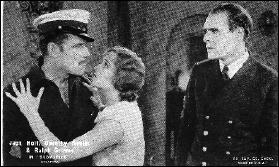
SUBMARINE. Columbia, 1928. Silent film with sound effects. Jack Holt, Dorothy Revier, Ralph Graves, Clarence Burton, Arthur Rankin. Director: Frank Capra. Shown at Cinefest 26, Syracuse NY, March 2006.
Ace deep-sea diver Jack Dorgan (Jack Holt) marries a woman he meets at a dancehall (Bessie, played by Dorothy Revier). When he’s called to work, Bessie, bored, goes out and meets Bob Mason (Ralph Graves), who, unknown to her, is Jack’s best friend.
Jack returns unexpectedly, finds the two together and throws Bob out of the house. When Bob is trapped in a sunken submarine, Jack, the only diver who might be able to reach the sub, sulks at home, unwilling to help the man who betrayed his friendship. A chance discovery reveals Bessie’s duplicity and Jack races to the rescue of the crew.
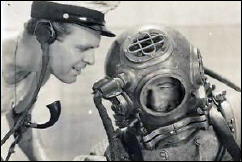
According to the program notes, this was Columbia’s first “A” picture, and Capra was brought on after Harry Cohn fired the original director. Capra obtains the assistance of the Navy, shooting on location in San Pedro with 100 Navy seamen as extras.
The last third of the film keeps cutting from the trapped seamen to the rescue attempt, with the tension building until the final minutes of the film. Capra’s skill with actors makes the shopworn triangle believable and Holt, one of my two favorite actors when I was a kid (the other was Buck Jones), is every boy’s idea of a resourceful hero.
Graves, hardly remembered today, is almost as good as Holt, and Revier is perfect as the girl you love to hate.
Thu 3 Apr 2014
FIRST YOU READ, THEN YOU WRITE
by Francis M. Nevins
I could have sworn I’d read all of Erle Stanley Gardner’s Perry Mason novels decades ago, but when I recently pulled out The Case of the Singing Skirt (1959) from my shelves nothing in it struck me as familiar.
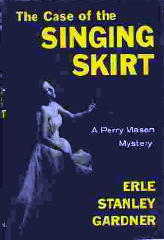
Club singer Ellen Robb is framed for theft and fired after refusing to help casino owner George Anclitas and his partner Slim Marcus trim wealthy Helman Ellis in a crooked poker game. Mason visits the casino and threatens Anclitas with a recent appellate decision holding that in a community property state like California a gambler’s spouse can recover any money the gambler lost.
Later Ellen finds a Smith & Wesson .38 in her suitcase and, fearing that Anclitas is out to frame her for something more serious than theft, goes to Mason again. In her presence, Mason happens to have a phone conversation with another lawyer in which he cites several cases holding that if a person is shot by two different people and could have died from either wound, only the one who fired the second shot is guilty of murder.
Without telling Ellen, Mason switches the gun she found in her bag for another of the same make and model that he happens to have in his safe. That evening he and Della Street secretly hide the gun he took from Ellen in the casino. Then Ellis’s wife Nadine is found shot to death — twice — aboard the couple’s yacht.
The police find the switched gun in Ellen’s possession and arrest her. Ballistics tests prove what seems impossible on its face: that the switched gun fired at least one of the fatal shots. In the courtroom scene, which takes up almost half the book, a third gun enters the picture and Mason eventually exposes some stupendous weapon-juggling.
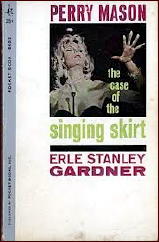
Anthony Boucher in his review for the New York Times (September 27, 1959) called Singing Skirt “one of the most elaborate problems of Perry Mason’s career, with switchings and counterswitchings of guns that baffle even the maestro… This is as chastely classic a detective story as you’re apt to find in these degenerate days.â€
True enough. After finishing the book I whipped up a document which traces the wanderings of all three .38s and, unless I messed up somewhere, seems to establish that all the weapon-switching rhymes. (This document gives away so much of the plot that I won’t include it here, but if you’re interested, follow this link to a separate webpage.)
But if Ellen had told Mason all she knew, the truth would have been obvious before the preliminary hearing even began. Why didn’t she? She had promised the real murderer she wouldn’t! Gardner’s need to camouflage this silliness explains why he jumps into court almost immediately after Ellen’s arrest, leaving out any subsequent conversations between Mason and his client.
And if that aspect of the plot isn’t silly enough, how about the woman, never seen before, who marches unbidden into the courtroom at the end of Chapter Fourteen and confirms Mason’s solution?
Gardner once said: “[E]very mystery story ever written has some loose threads… After all, on a trotting horse who is going to see the difference? The main thing is to keep the horse trotting and the pace fast and furious.â€
Well, I’m not sure that every mystery ever written has plot holes, but far too many of Gardner’s do. Nevertheless he remains a giant of the genre and one of the most important lawyer storytellers of the 20th century. Which is why he gets a chapter to himself in my next book.
It’s called Judges & Justice & Lawyers & Law: Essays on Jurisfiction and Juriscinema and will be published later this year by Perfect Crime Books. At least six of its ten chapters deal with matters that should interest readers of this column: three on major American lawyer fiction writers (Melville Davisson Post, Arthur Train and, of course, Gardner) and another three on a trio of notable law-related movies (Cape Fear, Man in the Middle, The Penalty Phase).
The longest chapter in the book is called “When Celluloid Lawyers Started to Speak†and covers law-related movies from the first years of talking pictures, many of which have a crime or mystery element.
If you happen to groove on Westerns as well as whodunits, there are also chapters on law-related shoot-em-ups from the 1930s but after Hollywood began strictly enforcing its Motion Picture Production Code (July 1, 1934) and on what I like to call Telejuriscinema, which means law-related episodes of TV Western series from the Fifties and Sixties.
I expect this gargantua to run close to 600 pages, the sort of book Harry Stephen Keeler once described as perfectly designed to jack up a truck with. As more information becomes available I’ll report it in future columns.
Since one of the dozens of movies I discuss in the Celluloid Lawyers chapter may have played a role in Gardner’s work, I may as well close this column with a page or so from my book, as a sort of sneak preview of things to come.
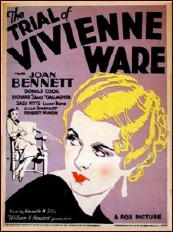
In the early Perry Mason novels, which were heavily influenced by Hammett and especially by The Maltese Falcon, we are allowed to see only what happens in Mason’s presence. But soon after the Saturday Evening Post began serializing the Masons prior to their book publication, scenes with other characters taking place before Perry enters the picture became commonplace.
Where did Gardner get this notion? Quite possibly from a fascinating but little-known movie dating from the early years of talkies. The Trial of Vivienne Ware (Fox, 1932) was directed by William K. Howard from a screenplay based on Kenneth M. Ellis’ 1931 novel of the same name.
It opens with the title character (Joan Bennett) and her fiancé, architect Damon Fenwick (Jameson Thomas) going to the Silver Bowl nightclub where Vivienne is insulted by Fenwick’s former lover, singer Dolores Divine (Lilian Bond).
After taking Vivienne home, Fenwick returns to the club to pick up Dolores. The next day Vivienne sends Fenwick a letter she comes to regret. Several hours later the police arrest her for his murder. Representing her is attorney John Sutherland (Donald Cook), who is also in love with her — an element we never find in a Perry Mason novel.
The trial, perhaps the most swift-paced in any movie, begins with a mountain of evidence against Vivienne. One: On the morning after the nightclub scene she visited Fenwick’s house, walked in on Dolores in sexy pajamas eating breakfast with him, and stalked out furious. Two: Immediately afterwards she sent Fenwick a letter which might be construed as threatening.
Three: Her handkerchief was found near Fenwick’s body. Four: A neighbor claims to have seen her entering Fenwick’s house that night. Vivienne denies being anywhere near the house at the time of the murder but Sutherland doesn’t believe her. Nevertheless he puts her on the stand and she testifies as follows.
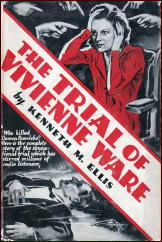
One: Her letter to Fenwick was meant to break their engagement, not to threaten him. Two: She must have dropped her handkerchief during her breakfast visit to Fenwick’s house. Three: At the time of the murder she was at a hockey game which she left early because she felt ill.
The district attorney (Alan Dinehart) cross-examines her so ruthlessly that she breaks down and sobs that even her own lawyer doesn’t believe her. At this point we find ourselves in the juristic Cloud Cuckoo Land that most Hollywood law films sooner or later enter: the prosecutor calls the defense lawyer as a witness! (How many times has Hamilton Burger pulled the same stunt with Mason?)
Changing Vivienne’s plea from not guilty to self-defense, Sutherland testifies that he attended the hockey match with her and, when she left early, followed her to Fenwick’s house. On the next day of trial Sutherland proceeds as if he were still pleading his client not guilty. First he calls witnesses who put Dolores Divine at Fenwick’s house at the time of the murder.
Then he calls Dolores herself, who testifies — as dozens of characters in Mason novels would do after her — that she found the body and said nothing about it but isn’t the murderer. (The film isn’t clear about this but apparently Vivienne, like so many of Mason’s clients, had done the same.)
I won’t delve any further into the plot but at the end of the picture spectators are roaring, flashbulbs blazing, lawyer and client embracing, and the jury returning a verdict of — well, can’t you guess? All this in less than 60 minutes!
We’ll never know if Gardner saw this movie, or perhaps read the novel it was based on, but the resemblance between the pattern here and that of so many middle-period Masons is remarkable.
Wed 2 Apr 2014
Posted by Steve under
Reviews[4] Comments
IT IS PURELY MY OPINION
Reviews by L. J. Roberts
CYNTHIA HARROD-EAGLES – Hard Going. Severn House, hardcover, February 2014. Police procedural: DI Bill Slider, 16th in series.

First Sentence: Slider’s wheels were in dock.
Although D.I. Bill Slider isn’t particularly looking forward to a week off from work, he hadn’t planned on a murder saving him from time in shopping malls. A well-known local philanthropist is dead. The evidence indicates he knew his killer. Coming up with suspects isn’t a problem. Discovering a motive and evidence proves to be much harder.
From the very beginning, you are pulled in by the author’s voice and delightful, very dry, humor: “but Kate [Slider’s daughter] merely rolled her eyes. It was her response to everything. She must have eye-muscles like a boxer’s biceps, Slider thought.â€
It’s refreshing to have a DI who is not an angst-ridden. He’s divorced with two older kids, but remarried with a wife, baby, another on the way and a live-in dad. This provides us just enough exposure to, and the normal problems of, his home life. We see Slider’s kinship to Atherton, his second, and to his team.
It is through Porson, Slider’s boss and something of a figure of fun that we see the author’s true mastery of language. One has to be truly dexterous to create the amazing malaprops she does and her incredible imagery.
Hard Going at the heart of it all, is a true police procedural, proving you don’t need a lot of violence or profanity to still have a mystery with an edge and an excellent plot twist. Slider and his team follow the clues and shift through the evidence. I, for one, will continue to follow this very good series.
Rating: Very Good.
Tue 1 Apr 2014
Posted by Steve under
Reviews[7] Comments
THE BACKWARD REVIEWER
William F. Deeck
LAURENCE DWIGHT SMITH – Follow This Fair Corpse. Mystery House, hardcover, 1941; Mystery Novel of the Month #29, digest-sized paperback, n.d. [1941] as The Case of the Rented Coffin.
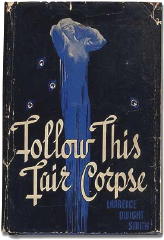
With a publisher, mystery-novel authors, and agents gathered for a weekend, almost anything can happen. It doesn’t help matters that the publisher is a man who doesn’t read books, who takes nude photos of his girlfriends who then often become or are other people’s girlfriends, and who suspects his wife is trying to kill him.
The publisher invites the writers to his mansion to propose a contest in which each writer will construct a novel from the same first chapter. Acting out the first chapter himself, the publisher apparently goes further than he had planned.
On the scene is Dick Whelan, M.D., Smith’s series character. He is there at the behest of the police and is taking the place of a pseudonymous mystery writer who is a doctor. Not too demanding a task apparently; as a policeman remarks, “Any ass can fake being a writer.” At the end, Whelan solves a series of murders.
This novel was not as enjoyable as I thought it would be from its amusing start; on the other hand, it’s a good mystery. In addition, there are some perhaps moot quotations about publishers — “You can’t leave anything to those damned fools!” — and detective-story writers and their work — “It’s always been a mystery to me why otherwise intelligent people read detective stories. Still, I suppose it’s no worse than going to the movies.”
— From The MYSTERY FANcier, Vol. 13, No. 2, Spring 1991.
Bibliographic Note: The earlier case solved by Dr. Whelan was The Corpse with the Listening Ear (Mystery House, 1940).
« Previous Page





